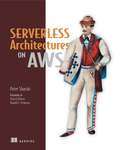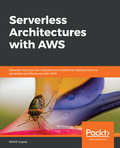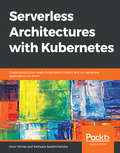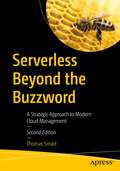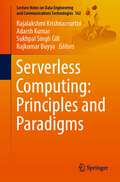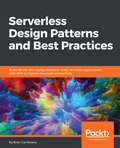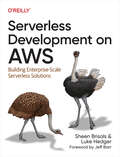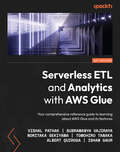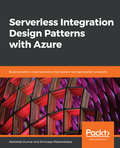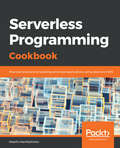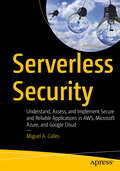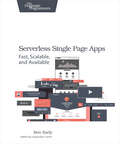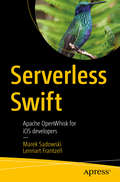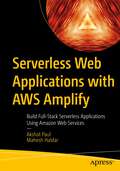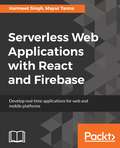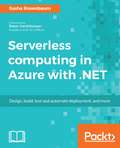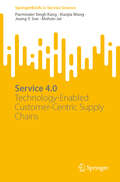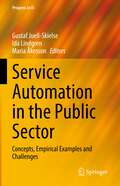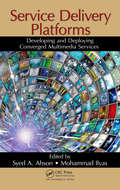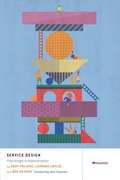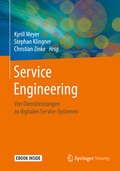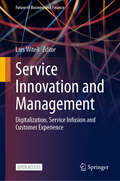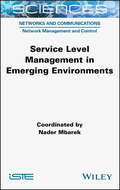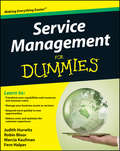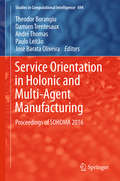- Table View
- List View
Serverless Architectures on AWS: With examples using AWS Lambda
by Peter Sbarski Sam KroonenburgSummaryServerless Architectures on AWS teaches you how to build, secure and manage serverless architectures that can power the most demanding web and mobile apps. Forewords by Patrick Debois (Founder of devopsdays) and Dr. Donald F. Ferguson (Columbia University).Purchase of the print book includes a free eBook in PDF, Kindle, and ePub formats from Manning Publications.About the TechnologyThere's a shift underway toward serverless cloud architectures. With the release of serverless computer technologies such as AWS Lambda, developers are now building entirely serverless platforms at scale. In these new architectures, traditional back-end servers are replaced with cloud functions acting as discrete single-purpose services. By composing and combining these serverless cloud functions together in a loose orchestration and adopting useful third-party services, developers can create powerful yet easy-to-understand applications.About the BookServerless Architectures on AWS teaches you how to build, secure, and manage serverless architectures that can power the most demanding web and mobile apps. You'll get going quickly with this book's ready-made real-world examples, code snippets, diagrams, and descriptions of architectures that can be readily applied. By the end, you'll be able to architect and build your own serverless applications on AWS.What's InsideFirst steps with serverless computingImportant patterns and architecturesWriting AWS Lambda functions and using the API GatewayComposing serverless applications using key services like Auth0 and FirebaseSecuring, deploying, and managing serverless architecturesAbout the ReaderThis book is for software developers interested in back end technologies. Experience with JavaScript (node.js) and AWS is useful but not required.About the AuthorDr. Peter Sbarski is a well-known AWS expert, VP of engineering at A Cloud Guru, and head of Serverlessconf.Table of ContentsPART 1 - FIRST STEPSGoing serverlessArchitectures and patternsBuilding a serverless applicationSetting up your cloudPART 2 - CORE IDEASAuthentication and authorizationLambda the orchestratorAPI GatewayPART 3 - GROWING YOUR ARCHITECTUREStorageDatabaseGoing the last mileAPPENDIXESServices for your serverless architectureInstallation and setupMore about authentication and authorizationLambda insiderModels and mapping
Serverless Architectures with AWS: Discover How You Can Migrate From Traditional Deployments To Serverless Architectures With Aws
by Mohit GuptaNo AWS experience is assumed but the book is targeted to technical professionals. Examples will be provided using Java or Node.js but AWS provides SDKs for other programming languages, including Python and .NET. These languages are supported by the AWS Lambda functions too.
Serverless Architectures with Kubernetes
by Onur Yılmaz Sathsara SarathchandraThis course is for software developers and DevOps engineers who have basic or intermediate knowledge about Kubernetes and want to learn how to create serverless applications that run on Kubernetes. Those who want to design and create serverless applications running on the cloud, or on-premise Kubernetes clusters will also find this course useful.
Serverless Beyond the Buzzword: A Strategic Approach to Modern Cloud Management
by Thomas SmartKnow how Serverless and cloud-native systems work, their benefits and roles in automating and optimizing organizations, and the challenges to be considered. Anyone interested in Serverless architecture will benefit from this book, regardless of their level of technical understanding. This revised and expanded new edition explains many related terms, such as microservices, cloud-native, architecture, several relevant AWS services, and how it all works together to produce cost-effective, scalable solutions in the cloud. The book starts at a high level and gradually gets more in-depth and technical.The less technical decision maker will learn how Serverless can affect finance, security, people, and compliance. The book touches on important decisions, such as selecting and working with external or internal specialists and teams; finding, evaluating, and training them; and the flexibility and dynamics available within digital projects. Deployment automation and DevOps also feature heavily in this book, and you will find real-world use cases and examples of Serverless architecture to get you started. It's worth noting that this book is not a development guide; it gives you a comprehensive understanding of what Serverless is so you can make informed decisions for your organization and projects. What You’ll Learn Understand Serverless architecture and strategyUnderstand modern cloud management strategy, governance, and organizational team structureHandle budget planning and managementGet started with Serverless architecture designGain knowledge of best practices and security, as well as data management and DevOpsStudy proactive logging, operations, architecture examples, case studies, and more Who This Book Is For Anyone interested in a deep understanding of Serverless and how it can impact organizations and projects, regardless of their technical level. Strategic insights are provided for entrepreneurs and executives, planning and team insights for project managers, and technical insights for architects and team leads. Cloud consultants working with enterprises can read everything for a full, in-depth understanding of the topic. Other readers, such as less technical CTOs/CIOs, VPs, entrepreneurs, product owners, project managers, etc., can get what they need from the first 5-7 chapters. More technical readers and those experienced with Serverless can skim through the first 3 chapters and start with the security deep dive in Chapter 4.
Serverless Computing: Principles and Paradigms (Lecture Notes on Data Engineering and Communications Technologies #162)
by Rajkumar Buyya Rajalakshmi Krishnamurthi Adarsh Kumar Sukhpal Singh GillThis book explores how advances in graphic processing units (GPUs), programmable logic devices (TPUs), and field-programmable gate arrays have altered the serverless computing landscape (FPGAs). Distributed system architectures and implementations have undergone significant changes due to the popularity of serverless computing. Making and releasing product applications, doing market research, and maintaining customer interactions might all benefit from the reduced infrastructure expenses made possible by serverless computing. This book is a great resource for teachers and students interested in learning more about serverless computing. Some of the main questions surrounding serverless technology, such as scalability and performance distribution, are answered. Concepts and fundamentals of computing performance such as cost-free operation, good time and resource management, fairness, and interoperability are discussed. Serverless is at the forefront of this shift, which has made data-intensive, distributed applications, and open-source platforms essential for any modern computer to function. Data-centric queuing, real-time logging and monitoring, querying, and alarms are all examples of serverless services.
Serverless Design Patterns and Best Practices: Build, secure, and deploy enterprise ready serverless applications with AWS to improve developer productivity
by Brian ZambranoGet started with designing your serverless application using optimum design patterns and industry standard practicesKey FeaturesLearn the details of popular software patterns and how they are applied to serverless applicationsUnderstand key concepts and components in serverless designsWalk away with a thorough understanding of architecting serverless applicationsBook DescriptionServerless applications handle many problems that developers face when running systems and servers. The serverless pay-per-invocation model can also result in drastic cost savings, contributing to its popularity. While it's simple to create a basic serverless application, it's critical to structure your software correctly to ensure it continues to succeed as it grows. Serverless Design Patterns and Best Practices presents patterns that can be adapted to run in a serverless environment. You will learn how to develop applications that are scalable, fault tolerant, and well-tested.The book begins with an introduction to the different design pattern categories available for serverless applications. You will learn the trade-offs between GraphQL and REST and how they fare regarding overall application design in a serverless ecosystem. The book will also show you how to migrate an existing API to a serverless backend using AWS API Gateway. You will learn how to build event-driven applications using queuing and streaming systems, such as AWS Simple Queuing Service (SQS) and AWS Kinesis. Patterns for data-intensive serverless application are also explained, including the lambda architecture and MapReduce.This book will equip you with the knowledge and skills you need to develop scalable and resilient serverless applications confidently.What you will learnComprehend the popular design patterns currently being used with serverless architecturesUnderstand the various design options and corresponding implementations for serverless web application APIsLearn multiple patterns for data-intensive serverless systems and pipelines, including MapReduce and Lambda ArchitectureLearn how to leverage hosted databases, queues, streams, storage services, and notification servicesUnderstand error handling and system monitoring in a serverless architecture a serverless architectureLearn how to set up a serverless application for continuous integration, continuous delivery, and continuous deploymentWho this book is forIf you're a software architect, engineer, or someone who wants to build serverless applications, which are non-trivial in complexity and scope, then this book is for you. Basic knowledge of programming and serverless computing concepts are assumed.
Serverless Development on AWS: Building Enterprise-Scale Serverless Solutions
by Sheen Brisals Luke HedgerThe adoption of serverless is on the rise, but until now, little guidance has been available for development teams that want to apply this technology on AWS. This definitive guide is packed with architectural, security, and data best practices and patterns for architects and engineers who want to build reliable enterprise-scale serverless solutions.Sheen Brisals, an AWS Serverless Hero, and Luke Hedger, an AWS Community Builder, outline the serverless adoption requirements for an enterprise, examine the development tools your team needs, and explain in depth the nuances of testing event-driven and distributed serverless services. You'll gain practical guidance for keeping up with change and learn how to build serverless solutions with sustainability in mind.Examine the serverless technology ecosystem and AWS services needed to develop serverless applicationsLearn the approach and preparation required for a successful serverless adoption in an enterpriseLearn serverless architectures and implementation patternsDesign, develop, and test distributed serverless microservices on AWS cloudApply security best practices while building serverless solutionsIdentify and adapt the implementation patterns for your particular use caseIncorporate the necessary measures for observable serverless applicationsImplement sustainable serverless applications in the cloud
Serverless ETL and Analytics with AWS Glue: Your comprehensive reference guide to learning about AWS Glue and its features
by Vishal Pathak Subramanya Vajiraya Noritaka Sekiyama Tomohiro Tanaka Albert QuirogaBuild efficient data lakes that can scale to virtually unlimited size using AWS GlueKey FeaturesLearn to work with AWS Glue to overcome typical implementation challenges in data lakesCreate and manage serverless ETL pipelines that can scale to manage big dataWritten by AWS Glue community members, this practical guide shows you how to implement AWS Glue in no timeBook DescriptionOrganizations these days have gravitated toward services such as AWS Glue that undertake undifferentiated heavy lifting and provide serverless Spark, enabling you to create and manage data lakes in a serverless fashion. This guide shows you how AWS Glue can be used to solve real-world problems along with helping you learn about data processing, data integration, and building data lakes.Beginning with AWS Glue basics, this book teaches you how to perform various aspects of data analysis such as ad hoc queries, data visualization, and real-time analysis using this service. It also provides a walk-through of CI/CD for AWS Glue and how to shift left on quality using automated regression tests. You'll find out how data security aspects such as access control, encryption, auditing, and networking are implemented, as well as getting to grips with useful techniques such as picking the right file format, compression, partitioning, and bucketing. As you advance, you'll discover AWS Glue features such as crawlers, Lake Formation, governed tables, lineage, DataBrew, Glue Studio, and custom connectors. The concluding chapters help you to understand various performance tuning, troubleshooting, and monitoring options.By the end of this AWS book, you'll be able to create, manage, troubleshoot, and deploy ETL pipelines using AWS Glue.What you will learnApply various AWS Glue features to manage and create data lakesUse Glue DataBrew and Glue Studio for data preparationOptimize data layout in cloud storage to accelerate analytics workloadsManage metadata including database, table, and schema definitionsSecure your data during access control, encryption, auditing, and networkingMonitor AWS Glue jobs to detect delays and loss of dataIntegrate Spark ML and SageMaker with AWS Glue to create machine learning modelsWho this book is forThis book is for ETL developers, data engineers, and data analysts who want to understand how AWS Glue can help you solve your business problems. Basic knowledge of AWS data services is assumed.
Serverless Integration Design Patterns with Azure: Build powerful cloud solutions that sustain next-generation products
by Abhishek Kumar Srinivasa MahendrakarA practical guide that helps you progress to using modern integration methods and leverage new cloud capability modelsKey FeaturesDesign critical hybrid integration solutions for your organizationGain in-depth knowledge of how to build cloud-native integration solutionsLeverage cognitive services to build smart cloud solutionsBook DescriptionWith more enterprises adapting cloud-based and API-based solutions, application integration has become more relevant and significant than ever before. Parallelly, Serverless Integration has gained popularity, as it helps agile organizations to build integration solutions quickly without having to worry about infrastructure costs. With Microsoft Azure’s serverless offerings, such as Logic Apps, Azure Functions, API Management, Azure Event Grid and Service Bus, organizations can build powerful, secure, and scalable integration solutions with ease.The primary objective of this book is to help you to understand various serverless offerings included within Azure Integration Services, taking you through the basics and industry practices and patterns. This book starts by explaining the concepts of services such as Azure Functions, Logic Apps, and Service Bus with hands-on examples and use cases. After getting to grips with the basics, you will be introduced to API Management and building B2B solutions using Logic Apps Enterprise Integration Pack.This book will help readers to understand building hybrid integration solutions and touches upon Microsoft Cognitive Services and leveraging them in modern integration solutions. Industry practices and patterns are brought to light at appropriate opportunities while explaining various concepts.What you will learnLearn about the design principles of Microsoft Azure Serverless IntegrationGet insights into Azure Functions, Logic Apps, Azure Event Grid and Service BusSecure and manage your integration endpoints using Azure API ManagementBuild advanced B2B solutions using Logic Apps, Enterprise Integration PackMonitor integration solutions using tools available on the marketDiscover design patterns for hybrid integrationWho this book is forServerless Integration Design Patterns with Azure is for you if you are a solution architect or integration professional aiming to build complex cloud solutions for your organization. Developers looking to build next-level hybrid or cloud solutions will also find this book useful. Prior programming knowledge is necessary.
Serverless Programming Cookbook: Practical Solutions To Building Serverless Applications Using Java And Aws
by Heartin KanikathottuThis book is for developers who would like to gain practical solutions to common problems while building their serverless application. Basic programming knowledgeis assumed.
Serverless Security: Understand, Assess, and Implement Secure and Reliable Applications in AWS, Microsoft Azure, and Google Cloud
by Miguel A. CallesApply the basics of security in serverless computing to new or existing projects. This hands-on guide provides practical examples and fundamentals. You will apply these fundamentals in all aspects of serverless computing: improving the code, securing the application, and protecting the infrastructure. You will come away having security knowledge that enables you to secure a project you are supporting and have technical conversations with cybersecurity personnel. At a time when there are many news stories on cybersecurity breaches, it is crucial to think about security in your applications. It is tempting to believe that having a third-party host the entire computing platform will increase security. This book shows you why cybersecurity is the responsibility of everyone working on the project. What You Will Learn Gain a deeper understanding of cybersecurity in serverless computingKnow how to use free and open source tools (such as the Node Package Manager, ESLint, and VSCode) to reduce vulnerabilities in your application codeAssess potential threats from event triggers in your serverless functionsUnderstand security best practices in serverless computingDevelop an agnostic security architecture while reducing risk from vendor-specific infrastructure Who This Book Is For Developers or security engineers looking to expand their current knowledge of traditional cybersecurity into serverless computing projects. Individuals just beginning in serverless computing and cybersecurity can apply the concepts in this book in their projects.
Serverless Single Page Apps: Fast, Scalable, and Available
by Ben RadyDon't waste your time building an application server. See how to build low-cost, low-maintenance, highly available, serverless single page web applications that scale into the millions of users at the click of a button. Quickly build reliable, well-tested single page apps that stay up and running 24/7 using Amazon Web Services. Avoid messing around with middle-tier infrastructure and get right to the web app your customers want.You don't need to manage your own servers to build powerful web applications. This book will show you how to create a single page app that runs entirely on web services, scales to millions of users, and costs less per day than a cup of coffee.Using a web browser, a prepared workspace, and your favorite editor, you'll build a complete single page web application, step by step. Learn the fundamental technologies behind modern single page apps, and use web standards to create lean web applications that can take advantage of the newest technologies. Deploy your application quickly using Amazon S3. Use Amazon Cognito to connect with providers like Google and Facebook to manage user identities. Read and write user data directly from the browser using DynamoDB, and build your own scalable custom microservices with Amazon Lambda.Whether you've never built a web application before or you're a seasoned web developer who's just looking for an alternative to complex server-side web frameworks, this book describes a simple approach to building serverless web applications that you can easily apply or adapt for your own projects.What You Need:To follow the tutorial in this book, you'll need a computer with a web browser. You'll also need a text editor and a git client. Building this web application will require some sort of development web server. You can use your own, or you can also use the one included with the tutorial's prepared workspace. The included web server requires Ruby 2.0, although we also suggest few alternatives. To get started quickly, you need a basic understanding of HTML, CSS, and JavaScript. If you're new to these topics, you can get up to speed using links we'll provide in the Introduction.
Serverless Swift: Apache OpenWhisk for iOS developers
by Marek Sadowski Lennart FrantzellDecrease development time to market with Serverless Swift—the event-based modern architecture for full stack developers. This book reviews how to use the Apache OpenWhisk framework to enrich your standalone applications with cloud-based functionalities from data sources up to Artificial Intelligence. You'll leverage serverless in your mobile apps with use case scenarios and gain the skills that will allow you to create robust, performant, secure yet economically viable systems in a cloud native environment. Finally, you'll see how to participate in the creation and further development of this open source project with Apache Foundation, which is supported by IBM, Google, and othersServerless has become a new style of coding, and it can be used to offload your mobile apps without incurring unnecessary costs. Get a solid, hands-on introduction into serverless, function-as-a-service, and cloud function technologies and learn why startups and enterprises are so excited about using them. What You'll LearnEmploy Apache OpenWhisk in your appsExpand your iOS skills with Cloud Native Serverless programmingUse a Docker container as a Polyglot actionWho This Book Is ForDevelopers, development leaders in the enterprise, and startup CTOs who want to learn a leading technology for the cloud in order to enrich applications with SaaS, Social Networks, and cloud based AI and APIs.
Serverless Web Applications with AWS Amplify: Build Full-Stack Serverless Applications Using Amazon Web Services
by Akshat Paul Mahesh HaldarLearn the fundamentals of serverless applications and how to take advantage of time-tested Amazon Web Services (AWS) to build scalable apps. This book shows you how to work with the key features of your applications with minimum code, simple CLI commands and one-click deployments. You'll see how to manage authentication, standard UI components, database storage, filesystem, CI/CD pipeline and more. You'll also examine the architecture, strengths, scalability, and limitations of serverless, and how to use AWS Amplify effectively. You will use tools including React, Cognito, GraphQL, DynamoDB, Kinesis, and Sagemaker. AWS Amplify is the fastest and easiest way to build serverless web and mobile apps at scale, comprising tools and services that work independently and can be wired together to build scalable apps. What You'll Learn Build GraphQL and REST APIsModel data with Amplify DatastoresSet up a CI/CD pipeline with AmplifyRecord and make sense of user data analytics with KinesisBoost your application with AI/ML capability using Sagemaker Who This Book Is ForDevelopers who have worked on web technologies and want to learn how to build serverless applications and developers interested in making powerful applications using AWS that can then be wired using AWS Amplify.
Serverless Web Applications with React and Firebase: Develop real-time applications for web and mobile platforms
by Harmeet Singh Mayur TannaBuild rich and collaborative applications using client-side code with React, Redux, and FirebaseKey Features1) A practical guide covering the full stack for web development with React 16 and Firebase2) Leverage the power of Firebase Cloud Storage, messaging, functions, OAuth, and database security to develop serverless web applications.3) Develop high-performance applications without the hassle of setting up complex web infrastructure.Book DescriptionReactJS is a wonderful framework for UI development. Firebase as a backend with React is a great choice as it is easy, powerful, and provides great developer experience. It removes a lot of boilerplate code from your app and allows you to focus on your app to get it out quickly to users. Firebase with React is also a good choice for Most Viable Product (MVP) development.This book provides more practical insights rather than just theoretical concepts and includes basic to advanced examples – from hello world to a real-time seat booking app and Helpdesk applicationThis book will cover the essentials of Firebase and React.js and will take you on a fast-paced journey through building real-time applications with Firebase features such as Cloud Storage, Cloud Function, Hosting and the Realtime Database. We will learn how to secure our application by using Firebase authentication and database security rules. We will leverage the power of Redux to organize data in the front-end, since Redux attempts to make state mutations predictable by imposing certain restrictions on how and when updates can happen. Towards the end of the book you will have improved your React skills by realizing the potential of Firebase to create real-time serverless web applications.What you will learnInstall powerful React.js and Firebase tools to make development much more efficientCreate React components with Firebase to save and retrieve the data in real-timeUse Firebase Authentication to make your React user interface secureDevelop React and Firebase applications with Redux integration Firebase database security rulesFirebase Cloud Storage Integration to upload and store data on the cloudCreate a complete real-time application with React and firebaseUsing Firebase Cloud messaging and Cloud functions with ReactFirebase Cloud Storage integration with ReactWho this book is forThis book is for JavaScript developers who have some previous knowledge of React and want to develop serverless, full-stack applications but without the hassle of setting up a complex infrastructure.
Serverless computing with Azure and .NET
by Sasha RosenbaumThis book is for .NET developers who would like to learn about serverless architecture. Basic C# programming knowledge is assumed.
Service 4.0: Technology-Enabled Customer-Centric Supply Chains (SpringerBriefs in Service Science)
by Parminder Singh Kang Xiaojia Wang Joong Y. Son Mohsin JatThis book presents a systematic framework for Service 4.0, including service digitization, digitalization, and digital transformation, which is an integral part of Supply Chain 4.0 in coping with complex, dynamic, and interdependent systems. It provides a comprehensive state-of-the-art review of digital technologies to support Service 4.0 and Supply Chain 4.0, and discusses important pillars of customer-centric supply chain models. It then explains the role of big data in customer-centric service-based supply chains and links the different types of data needed to promote end-to-end transparency and value co-creation activities to promote these key pillars. Moreover, the book introduces practical models to support analytics for customer-centric supply chains and sheds light on how the industry practically uses existing models to promote service co-creation. A chapter of a case study on women's clothing e-commerce reviews and demonstrates how various data visualization and text mining methods can be used to uncover meaningful insights within the review data. The book is intended to help students and researchers quickly navigate through various technologies and future research directions in the areas of Service 4.0 and Supply Chain 4.0. It is also a valuable read for practitioners in this field.
Service Automation in the Public Sector: Concepts, Empirical Examples and Challenges (Progress in IS)
by Ida Lindgren Gustaf Juell-Skielse Maria ÅkessonThis edited volume highlights the latest advances in and findings from research on service automation in public sector organizations. The contributing authors use a mix of social and technological approaches to increase readers’ understanding of public service automation. The respective chapters discuss the automation of services in public organizations from a conceptual standpoint, present empirical examples of automation applications in public organizations, and consider the implementation-related challenges that can arise. The book’s overall goal is to aid and inspire researchers and practitioners to expand their knowledge of service automation in public organizations, while also providing a foundation for policy development and future research. Following a brief introductory chapter, the book addresses major gaps in our current understanding of service automation in public organizations, and provides suggestions for future research. Moreover, it argues that there is a continued need to observe and learn from empirical examples, and a need for more critical studies on the social and societal consequences of increased service automation in public organizations.
Service Delivery Platforms: Developing and Deploying Converged Multimedia Services
by Mohammad Ilyas Syed A. AhsonIt is becoming increasingly important for telecom operators to be able to provide service delivery platforms (SDP) quickly and efficiently in order to improve the time-to-revenue of value-added services. Presenting a rapid architecture solution to meet this challenge, Service Delivery Platforms: Developing and Deploying Converged Multimedia Service
Service Design: From Insight to Implementation
by Andrew Polaine Lavrans Løvlie Ben ReasonService Design is an eminently practical guide to designing services that work for people. It offers powerful insights, methods, and case studies to help you design, implement, and measure multichannel service experiences with greater impact for customers, businesses, and society.
Service Engineering: Von Dienstleistungen Zu Digitalen Service-systemen
by Kyrill Meyer Stephan Klingner Christian ZinkeDas Buch beleuchtet aktuelle Herausforderungen des Service Engineerings und zeigt dessen Entwicklung im Kontext digitaler Service-Systeme sowie Chancen und Möglichkeiten, die digitale Dienstleistungsangebote und vernetzte Lösungen bieten. Wissenschaftliche Ausführungen werden durch praxisorientierte Beispiele, welche die Anwendung der Lösungsansätze und Methoden demonstrieren, ergänzt. Damit betrachten die Autoren dieses Sammelbands einerseits die Evolution der systematischen Dienstleistungsentwicklung in Theorie und Praxis und stellen andererseits aktuelle Forschungsthemen und Entwicklungstendenzen vor. Dazu ziehen die Herausgeber Arbeiten der Partner des Forschernetzwerkes FOKUS Service Engineering heran. Die Beiträge sprechen sowohl Wissenschaftler als auch Vertreter der Praxis an.
Service Innovation and Management: Digitalization, Service Infusion and Customer Experience (Future of Business and Finance)
by Lars WitellThis open access book investigates how digitalization and service infusion are changing service provision and the customer experience. It highlights the central role of service management and service innovation in making these changes not only appear in theory but also implementing them in business practice. At the beginning of the 21st century, many manufacturing firms struggled to exploit the financial potential of service businesses, a phenomenon described as the service paradox. While many manufacturing firms are still struggling with this paradox, several firms (both service and manufacturing firms) are simultaneously struggling with digitalization. This phenomenon can be viewed as the digitalization paradox, i.e., as a situation in which companies invest in digitalization but struggle to reach the expected revenue growth. By applying the lens of service innovation to digitalization and service infusion, the book showcases how firms can overcome the service and digitalization paradoxes, transform service provision, and improve the customer experience. It offers comprehensive coverage, blending literature reviews, conceptualizations, empirical illustrations, and case studies to offer a multifaceted perspective on corporate strategies, illuminating pathways to address the challenges posed by the service and digitalization paradoxes. Built on the latest research from the CTF – Service Research Center at Karlstad University, Sweden, this book offers a valuable resource for managers seeking practical strategies and approaches to enhance their understanding and implementation of service management and marketing principles. It will also appeal to academics with an interest in service management and marketing.
Service Level Management in Emerging Environments
by Nader MbarekNetworks are now embedded in daily life thanks to smaller, faster, inexpensive components that are more powerful and increasingly connected. Parallel to this quantitative explosion of communication networks, technology has become more complex. This development comes with challenges related to management and control, and it has become necessary to manage the service level demands of the client to which the service provider commits. Different approaches to managing one or more service level components in different emerging environments are explored, such as: the Internet of Things, the Cloud, smart grids, e-health, mesh networking, D2D (Device to Device), smart cities and even green networking. This book therefore allows for a better understanding of the important challenges and issues relating to Quality of Service (QoS) management, security and mobility in these types of environment.
Service Management For Dummies
by Marcia Kaufman Fern Halper Robin Bloor HurwitzA plain-English guide to managing IT from the customer's perspectivePractical guidance on delivering and managing IT so that it meets the multiple needs and demands of a company and its customers and end-users-both inside and outside the organization-is hard to come by; this accessible book takes a common-sense approach that explains exactly what IT services are and how to fit them most effectively into a businessTopics include setting a framework, keeping costs down, improving efficiency, and maintaining standards and best practicesThis concept of how IT should be wired specifically into the goals and need of the company and its customers is part of a broader picture that includes ITIL, BPM, SOA, and Six Sigma
Service Orientation in Holonic and Multi-Agent Manufacturing
by Theodor Borangiu André Thomas Damien Trentesaux Paulo Leitão José Barata OliveiraThis volume gathers the peer reviewed papers presented at the 4th edition of the International Workshop "Service Orientation in Holonic and Multi-agent Manufacturing - SOHOMA'14" organized and hosted on November 5-6, 2014 by the University of Lorraine, France in collaboration with the CIMR Research Centre of the University Politehnica of Bucharest and the TEMPO Laboratory of the University of Valenciennes and Hainaut-Cambr#65533;sis. The book is structured in six parts, each one covering a specific research line which represents a trend in future manufacturing: (1) Holonic and Agent-based Industrial Automation Systems; (2) Service-oriented Management and Control of Manufacturing Systems; (3) Distributed Modelling for Safety and Security in Industrial Systems; (4) Complexity, Big Data and Virtualization in Computing-oriented Manufacturing; (5) Adaptive, Bio-inspired and Self-organizing Multi-Agent Systems for Manufacturing and (6) Physical Internet Simulation, Modelling and Control. There is a clear orientation of the SOHOMA'14 workshop towards complexity, which is a common view of all six parts. There is need for a framework allowing the development of manufacturing cyber physical systems including capabilities for complex event processing and data analytics which are expected to move the manufacturing domain closer towards cloud manufacturing within contextual enterprises. Recent advances in sensor, communication and intelligent computing technologies made possible the Internet connectivity of the physical world: the Physical Internet, where not only documents and images are created, shared, or modified in the cyberspace, but also the physical resources and products interact over Internet and make decisions based on shared communication.
